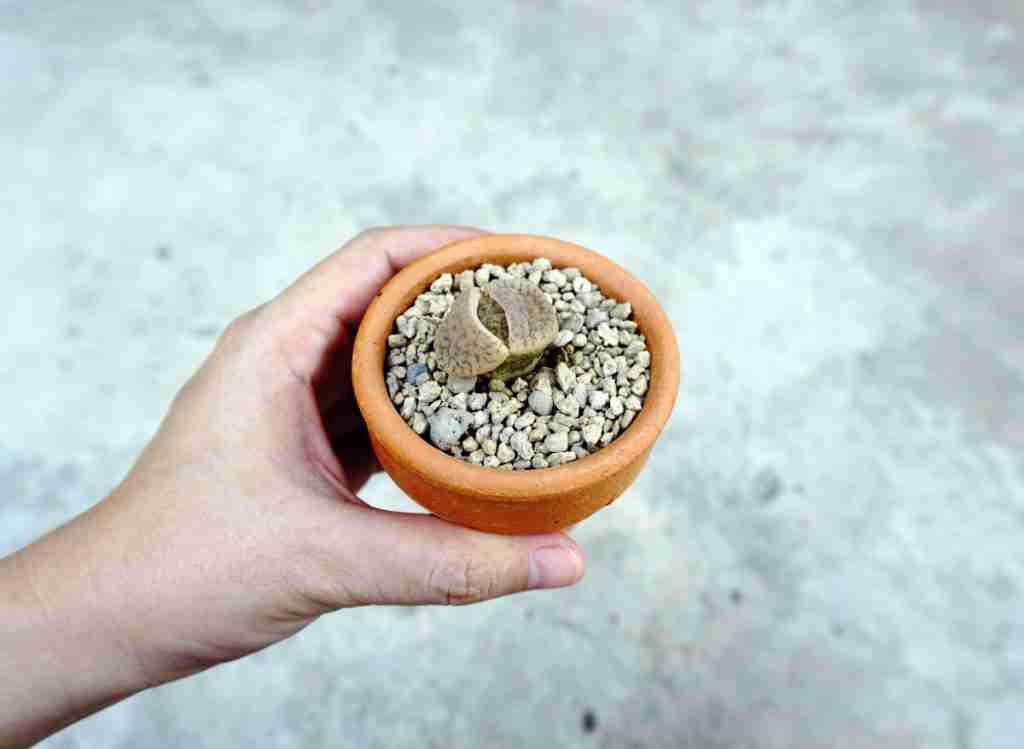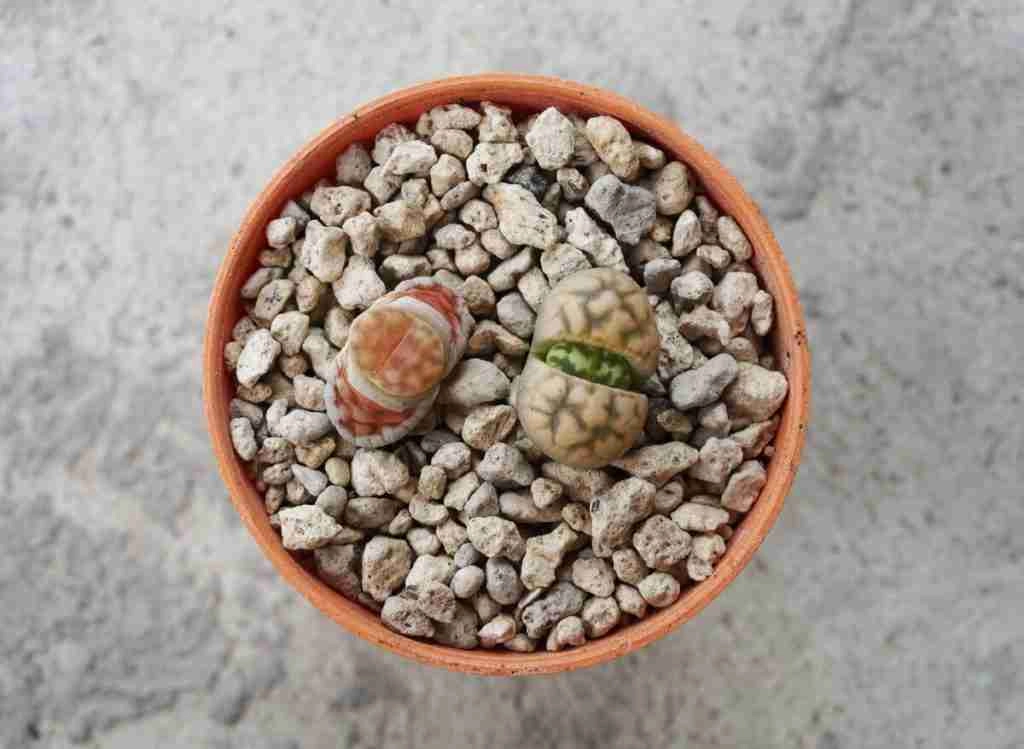
Lithops (AKA living stones or flowering stones) are the easiest yet the hardest succulents to care for. Because of their size, shape, and color, they look like small stones, perfectly blending in among the rocks as a means of protection.
In addition, properly watering Lithops keeps them healthy and strong because if you don’t water them properly at the right time, you will deal with splitting Lithops. But, exactly how to deal with splitting Lithops?
Generally, when Lithops start splitting, it is good to let them absorb the moisture from the old leaves into the new ones. Watering them might cause the old leaves to stay big and choke off the new leaves. In addition, like most succulents, inadequate light and overwatering are the most common causes of a Lithops’ demise.
Read on to find out everything you need to know about Lithops and how to deal with splitting Lithops.
See also: What to do About Succulents with Long Stems?
Lithops Characteristics
Lithops are tiny, fascinating plants from southern Africa that are relatively easy to grow indoors. Lithops’ name comes from their stone-like appearance, “lithos” meaning stone and “opsis” meaning like. Lithops can be pretty tricky to spot, even for expert gardeners with years of experience.
| Suitable Growing Site | – Gravely flats soils – Hills of sand – Decomposed granite – Quartzite – Limestone – Stony ridges – Rock – Schist – Quartz grit |
| Height | – From half to 1 inch (1.27 to 2.54 cm) high |
| Width | – From 1 to 3 inches (2.54 to 7.62 cm) wide |
| Sun Exposure | Lithops grow well when they can receive about 4 or 5 hours of direct sunlight in the early morning and partial shade during the afternoon. |
| Lithops Species | At least 37 species and over 145 varieties of Lithops |
| Lithops colors | – Gray – Brown – Rust – Green – And pink |
| Blooming Season | In general, most Lithops bloom during autumn and early winter to produce daisy-like yellow, white flowers with many petals or pale orange. |
| How Long Can You Keep Lithops? | You can keep Lithops in the same pot for about 10 or 20 years. And they can live between 40 or 50 years. |
| Pot Requirements | Use pots that are about 3 to 5 inches (7.62 to 12.7 cm) deep with drain holes to allow the roots enough room to grow. |
| Soil Requirement | Similar to cactus, Lithops require well-drained soil. |
| Maintenance requirements | Lithops are relatively easy to grow and low maintenance. |
| Fertilizer requirements | Lithops has low fertilizer requirements; when fertilizing, use high potassium and low nitrogen fertilizer. |
How Long Does Really It Take For Lithops To Split?
Depending on the environmental conditions in which you are growing Lithops, it takes them about a month or two to split. And when it happens, here’s how you deal with it.
See also: How To Successfully Repot Overgrown Succulents Like A Pro?
How To Deal With Splitting Lithops?
As it mainly happens due to overwatering, you need to let Lithops absorb the moisture from the old leaves into the new ones when they are in the process of splitting. Don’t water them when they are splitting. If you water them when they are splitting, the old leaves will stay big, and thus, they will choke off the new leaves.
Though light and other environmental conditions can play a role in the splitting of Lithops as well, overwatering is the main reason. So, you need to take care of it a lot if you want to deal with your splitting Lithops. In either way of splitting Lithops (as mentioned above), don’t water them for a while.
If an existing leaf splits randomly, don’t water it until it has healed. Apart from that, if it’s a new leaf that’s splitting, let it take the water out of the old leaves.
The new leaves will grow by absorbing the nutrients from the old leaves. Moreover, if Lithops are getting water through the roots, it will not be possible for old leaves to shrivel around the new leaves.
Now, you might be wondering about how often should you water lithops, then keep reading to learn how to properly water Lithops.
How Often Should You Water Lithops?
As a rule of thumb, how often you water Lithops depends on how quickly the potting medium dries out. Try to soak the plant and leave it to dry out completely for about 1 to 2 weeks.
The best to water Lithops is in the mornings so that the excess water evaporates and the upper soil layers dry out reasonably quickly.
If you overwater them, they can rot or produce new bodies at the wrong time of year. And, too little water, and they might become stunted.
Over-watering is one of the leading causes of the early death of Lithops; therefore, it is essential to water only during certain stages and keep the soil dry at other stages of their growth.
See also: How to Effectively Propagate Haworthia Succulents
Tips On Watering Lithops:
- The best time to water Lithops is from late spring into summer.
- When Lithops plants go dormant in the summer, don’t water them.
- Re-start watering in late summer-early fall when the plants restart growing and blooming.
- The first sign of Lithops growth is when the splitting between leaves begins to separate in preparation for flowering.
- Try to leave Lithops dry during winter and spring.
- Ensure you stop watering them to allow the old leaf pair to dry out and the new pair to develop.
- Remember, the old leaves should dry up as the fresh leaves grow.
How Does Lithops Splitting Happen?
After Lithops flowers, it goes into dormancy, during which at least one new body develops. In the spring, it generally starts to reabsorb the old leaves as the new ones grow. Ultimately, the new body pushes out from the splitting between the old leaves.
The splitting of the new leaves forms at about 90 degrees to the old splitting. Eventually, the old leaves wither away to a dry, papery sheath on the side of the new body. Lithops need enough bright light, proper watering, and healthy soil drainage to thrive.
The splitting of Lithops takes place in two ways, and it mainly happens due to overwatering them.
- When faced with overwatering, the leaf has no place to accommodate this overload of water, so for the sake of adjusting, the leaf bursts open. It will look like your Lithops leaf has a split lip or a jagged cut on the Lithops leaf.
- In the other way of Lithops splitting, Lithops push the new leaves up from the root system. The new leaves replace the current leaves, and once the new leaves come in, the current leaves shrivel and die.
See also: How to Easily Propagate Succulents with Honey: A Complete Guide
Can You Split Lithops?
It is possible to propagate Lithops by dividing a multi-headed plant. For this, lift the plant first. Then, cut through the roots carefully, and replant them right away.
Because of their ability to store water, Lithops can survive in dry areas. Each plant consists of two succulent leaves blended in the shape of an inverted cone, even though some species will turn into multi-headed plants.
The splitting at the top of the plant means the division between the two leaves. The thick leaves can store enough water for the Lithops to survive for months without rain. In areas of drought, Lithops wilt and shrink below.
Where Do You Put Lithops?
Generally, the best location is a southern window. Alternatively, unobstructed eastern exposure will also work.
In addition, lithops will begin to grow slender and elongated without adequate sunlight, lean to one side to receive more light, lose their beautiful colors, and turn greenish.
See also: Here’s How To Easily and Successfully Water Succulents Without Drainage.
Should I Water Lithops After Repotting?
You shouldn’t water them immediately after repotting, you should wait at least a week instead. Though watering after repotting a succulent plant depends upon the type of succulent plant you’ve repotted, it’s widely recommended to wait for a week at least.
Because while repotting a plant, its roots might get hurt. So to let these roots heal, it is necessary to wait for a week or so. When you water Lithops one week after repotting them, make sure that the soil is dry. Moreover, don’t drown the plant, wet it thoroughly instead.
How To Water Lithops During Different Seasons?
As it’s overwatering that causes Lithops splitting, for the most part, you need to know the right time to water Lithops. You might even have been wondering when to water them and when not to, as it’s an integral part of their care. So, here’s how you water them during different seasons.
1- Summer
Lithops don’t need to be watered during summer, so don’t water them. Watering Lithops in summer can kill them as they are dormant in this season. They prefer no humidity or rain in this season. They will become mushy and rot if you water them in summer.
You can only water them in summer if you see that they’ve become much wrinkled. But still, you need to water them with only a small amount of water, and within a week, they’ll plump up again.
2- Autumn
Lithops resume growth in the early autumn. If you see a bud forcing its way out from between the leaves, that will be the first sign of your Lithops growth. After that, this shoot will become a flower, and the new leaves often begin around this time.
At the start of this season, you need to water Lithops like you are fully drenching the plant because this will jump up the growth. Water whenever necessary. If you see that the soil is still damp from the last time you watered Lithops, don’t water until it dries.
See also: Can You Really Plant Succulents In Rocks? Pros & Cons Of Doing So
3- Winter
Don’t water during the winter season. In winter, the new pair of Lithops leaves draw water from the old leaves. The new pair steadily grows as the old one will appear to shrivel over time. They need not be watered in winter; if you do so, the water will be consumed by the old leaves. This can stop the growth and the plant can die.
In this season, you should have Lithops completely untouched. Moreover, ensure that they aren’t exposed to below 55°F. They flourish in cold temperatures as they are mostly made of water.
4- Spring
In spring, wait till the old leaves shrivel up into paper-like husks. Once you see that happening, remove them, and resume watering.
First, to encourage the new bud to begin growth, you need to water lightly. After that, increase the amount of water eventually as needed.
See also: Can All Succulents Really Survive Winter? Here’s What I Think
Wrapping Up
Originating from southern Africa, Lithops are tiny, interesting plants that are low-maintenance houseplants.
Even though they are easy to care for, it is essential to learn how to deal with splitting Lithops to grow these long-lived plants successfully.


